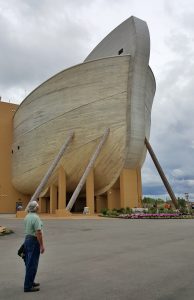 On our way up I-75 into northern Kentucky I found myself thinking about a Facebook friend, a Christian and a movie critic who works in Hollywood. Heading into a newly released faith-based film, she’ll post a little movie-critic prayer, “Dear Lord, please help it not be cheesy.” We were on the first leg of my Mom’s bucket list trip, headed to the Ark Encounter, a theme park with a Biblically scaled ark.
On our way up I-75 into northern Kentucky I found myself thinking about a Facebook friend, a Christian and a movie critic who works in Hollywood. Heading into a newly released faith-based film, she’ll post a little movie-critic prayer, “Dear Lord, please help it not be cheesy.” We were on the first leg of my Mom’s bucket list trip, headed to the Ark Encounter, a theme park with a Biblically scaled ark.
I’m happy to report this ark is not cheesy. From the outside it’s too big to be cheesy. It looks…epic.
And a little too gleaming?
God told Noah to build the original out of wood and cover it with pitch inside and out. I doubt it looked as impressive as the 300-cubit, three-keeled, silver-timbered ship perched in the Kentucky hills.
Or that the cabins, which put a cruise ship to shame, looked quite as beautiful.
 But who knows? The ark took fifty years to build. Noah could have contracted outside labor to help his family of eight construct it. And I’ve often wondered if the Ancients may have been more intelligent and stronger than we are. They were not the victims of so much genetic corruption. Descendant-wise they were much closer to Adam and Eve, who, if you’ve ever read Perelandra by C.S. Lewis, challenge us to rethink the stunning beauty and intellect of the first humans formed by God’s hand.
But who knows? The ark took fifty years to build. Noah could have contracted outside labor to help his family of eight construct it. And I’ve often wondered if the Ancients may have been more intelligent and stronger than we are. They were not the victims of so much genetic corruption. Descendant-wise they were much closer to Adam and Eve, who, if you’ve ever read Perelandra by C.S. Lewis, challenge us to rethink the stunning beauty and intellect of the first humans formed by God’s hand.
Still, if I ran this zoo I’d be inclined to give it a slightly more primitive look—boards that don’t look like they’ve been planed by hi-tech saws, at least a thin coating of pitch, cabins that aren’t decked out with multiple throw pillows, that sort of thing. But then it might not have quite the imaginative appeal…
This ark is designed to draw you into an immersive experience that will connect with your imagination, your heart and your beliefs. Entering you find yourself in a labyrinth of cages deep in the hull of the ship, surrounded by sounds of thunder and wind carrying over animal noises.
You see the great timbers and boards of the wooden infrastructure.
And you begin to think, yes, maybe it could have been something like this. C.S. Lewis asserted that we have, in addition to our reason, an intuitive way of knowing beyond reason and experience. We have this imaginative way of knowing absorbed from picture, metaphor, symbol and myth that is then shaped and critiqued by our logic and reason. Knowing in this imaginative way can awaken a dimension of awe and transcendence beyond what logic and reasons can give us.
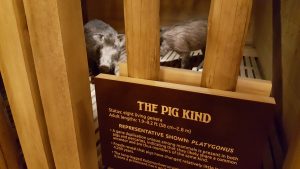 For those who take the Bible seriously, from the first full glimpse of the 550 foot-long ship, The Ark Encounter captures imaginations with exactly that sense of awe. In today’s very naturalistic world where a Biblical worldview is so marginalized and ridiculed, this concrete representation of a supernaturally prescribed structure, filled with divinely organized pairs of animals, sealed and protected by God to safely deliver its cargo to a post-flood world stands as a solid, sobering monument to the historicity of God’s Word and its message of judgment and his merciful deliverance.
For those who take the Bible seriously, from the first full glimpse of the 550 foot-long ship, The Ark Encounter captures imaginations with exactly that sense of awe. In today’s very naturalistic world where a Biblical worldview is so marginalized and ridiculed, this concrete representation of a supernaturally prescribed structure, filled with divinely organized pairs of animals, sealed and protected by God to safely deliver its cargo to a post-flood world stands as a solid, sobering monument to the historicity of God’s Word and its message of judgment and his merciful deliverance.
Just as the local museum of natural history helps visitors imagine the living reality of dinosaur fossils, the Ark Encounter helps us and our children imagine the reality of Genesis 6-8–what the giant ark might have looked like. How eight people and 1400 kinds of animals could have been kept safe inside. How the live cargo and supplies to sustain them would have fit on the ship.
However, local natural history museums present the story of the dinosaurs in the context of a naturalistic, Darwinian view of origins and history. Christians get used to tuning it out. Growing up in America our imaginations are starved for the portrayal of the Biblical narrative. In this respect the Ark Encounter is a visual feast.
But as Lewis said, our imaginative way of knowing must then be shaped and critiqued by reason. Is this story real? The ark is filled with exhibits that try to make the case: reasonable ways to feed and water so many animals, keep the air ventilated, and remove the waste. How plants might have been grown. How a blacksmithing shop might have helped with maintenance.
In addition to exhibits that offer evidence for the plausibility of the ark, visitors also find displays that make the case for young earth creationism: the world is 6-8,000 years old, God created it in six literal days, and the flood accounts for the catastrophic changes that modern science insist took millions of years.
The feeling you get as you read through the exhibits is that in order to be a Christian in good standing with those who built this ark you must believe the young earth interpretation of Genesis. If you believe God created an older earth or are agnostic about how long it took, then you must doubt the inspiration of Genesis and reject the authority of God’s Word. For millions of Christians now and throughout history neither is true.
If I ran this zoo I would offer more of a welcome to those who believe in the inspiration/inerrancy/reliability of Scripture, who absolutely believe that God created “the heavens and the earth,” but hold different views on the “how” of his creative agency.
On the historicity of Noah and his ark, as someone who takes the reliability of the Bible very seriously, some of the best evidence comes from subsequent passages in the Bible:
Isaiah 54:8-9 “In overflowing anger for a moment I hid my face from you, but with everlasting love I will have compassion on you,” says the LORD, your Redeemer. “This is like the days of Noah to me: as I swore that the waters of Noah should no more go over the earth, so I have sworn that I will not be angry with you, and will not rebuke you.”
Matthew 24:37-39 “As were the days of Noah, so will be the coming of the Son of Man. For as in those days before the flood they were eating and drinking, marrying and giving in marriage, until the day when Noah entered the ark, and they were unaware until the flood came and swept them all away, so will be the coming of the Son of Man.”–Jesus
The Lord Jesus and his Father confirm both the reality of Noah, the ark, and a flood that swept away a generation of violent, unbelieving people. Isn’t it ironic that the ark has become a sweet little floating zoo surrounded by a rainbow, a theme for children’s nurseries?
If I ran this zoo I would offer an ark reality check along the lines of this book in an exhibit. Why would we choose a theme that encompassed such disaster and death for a child’s room or Kid’s Zone decoration?
We like to focus on the beauty of the ark, how, like Christ, it offers a life of forgiveness, blessing. and deliverance from the terrible consequences of going our own way and forgetting God. Like the people of Noah’s day we don’t want to think about judgment. But that doesn’t change the inevitable reality. Christ died a horrific death so we would not have to endure a horrific judgment. If the consequences weren’t so grim, the good news wouldn’t be so good.
Acts 17:30-31 The times of ignorance God overlooked, but now he commands all people everywhere to repent, because he has fixed a day on which he will judge the world in righteousness by a man whom he has appointed; and of this he has given assurance to all by raising him from the dead.”
Even with the drawbacks I mentioned, even with problems with the evidence I didn’t discuss, I’m glad I visited the Ark Encounter. It was indeed epic.
I had never thought deeply about the challenges of so much food storage and animal care. What it might have been like to live for over a year on this ship. How to build the hull so it could plow through rough seas yet settle without tipping over when the water subsided. What it took to partner with God in his great work of redemption. What measure of faith it really required. I enjoyed engaging more deeply with the story than I ever had before.
Especially on a rainy day…
Have you visited the Ark Encounter? What did you think? Any questions about it? Please respond in the comments below…

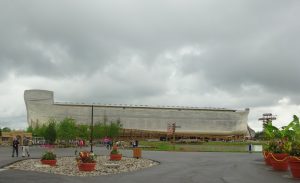
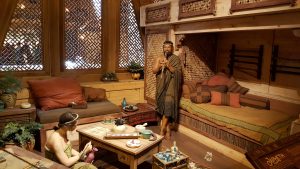

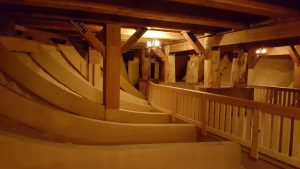
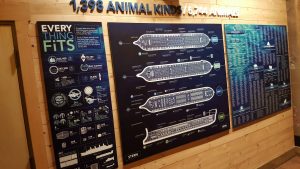

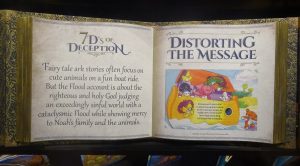
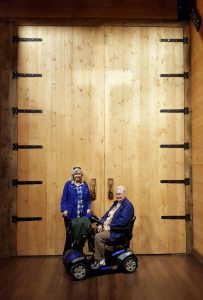
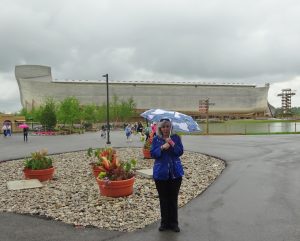
Years ago, I saw the depiction of the building of the ark, by a Ct. artist . It showed the extensive forest and gardens that had to be grown, harvested and prepared i.e.ground, dried and packed for storage. The forests were planted and harvested for the timbers to build the ark. It was a part of the story I had never thought about; where do you get the food to feed 1400 animals for that long? Thank you for a very informative blog. I will chew on this all day , and probably longer.
Thanks, Janet. The creators of the ark have thought more deeply about the challenges involved than I have ever considered. I appreciated all their work and creativity that helps the Bible come to life. It also helped me more deeply appreciate the years and years of hard work undertaken by Noah and his family with no precedent and simply God’s warning to go on. Hebrews 11:7 “By faith Noah, being warned by God concerning events as yet unseen, in reverent fear constructed an ark for the saving of his household. By this he condemned the world and became an heir of the righteousness that comes by faith.”